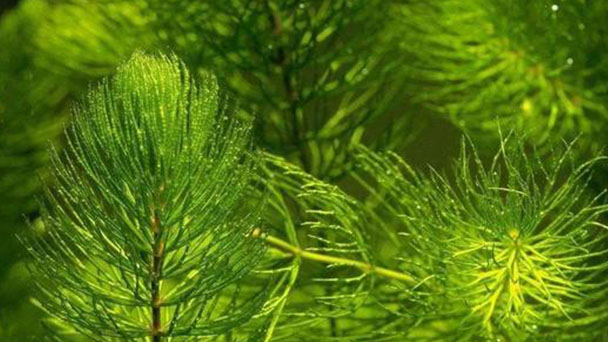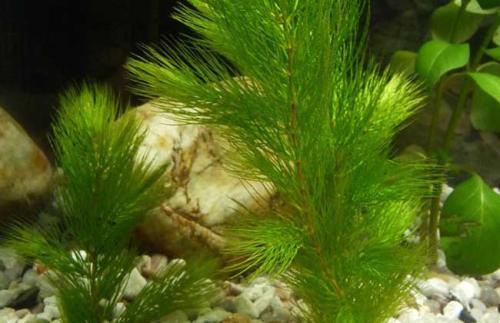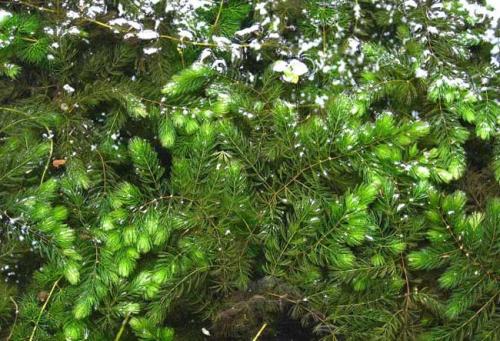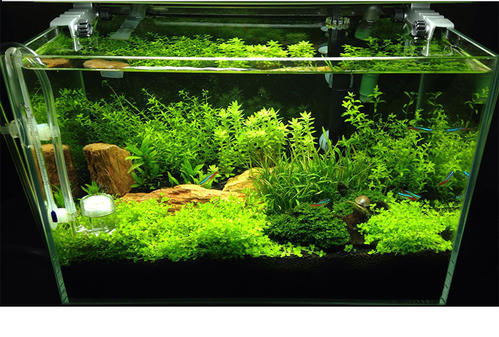Coontail Plant Profile
Written by Maggie
Dec 07 2021

Ceratophyllum demersum, commonly known as hornwort, rigid hornwort, coontail plant, or coon's tail, is a species of Ceratophyllum. It is a submerged, free-floating aquatic plant, with a cosmopolitan distribution, native to all continents except Antarctica. It is a harmful introduced weed in New Zealand.
Coontail is a perennial native of small lakes and used to be found in ponds, ditches and other places. It can be used as feed for pigs, fish and poultry. With whole grass as medicine, four seasons can be picked, dried. It can attend blood heat vomiting blood, coughing up blood, heat and astringency.
Coontail Plant Picture

Coontail Plant Characteristics
Coontail Plant is a perennial submerged aquatic herb; Stems are 40-150 cm long, smooth, branched. Leaves are 4-12 whorled, 1-2 times dichotomous, lobes filiform, or filamentous, 1.5-2 cm long, 0.1-0.5 mm wide, apex with white cartilaginous bone, margin with only a few fine teeth on one side.
Coontail flowers ca. 2 mm in diameter; Bracts 9-12, striate, 1.5-2 mm long, light green, transparent, apex with 3 teeth and purplish hairs; Stamens 10-16, slightly dense; The ovary is ovoid, style drills like. Nuts are broadly elliptic, 4-5 mm long, ca. 2 mm wide, black, smooth, margin wingless, 3-spined, terminal spines (persistent style) 8-10 mm long, apex hooked, base 2 spines obtuse, 4-7 mm long, apex tapering to spines.
Coontail flowering period is June to July, and fruiting period is August to October.
Coontail Plant Distribution
Coontail groups are found in freshwater ponds, ditches, steady streams, hot spring streams and reservoirs below 2,700 meters above sea level, and are often found in 1-3 meters deep water species, forming dense underwater communities. It is widely distributed in China (Northeast China, North China, East China, Taiwan), Mongolia, Korea, Japan, Malaysia, India, Russia and some other European countries, North Africa and North America.
Coontail Plant Growth Habit
Dormancy germination
Coontail seeds have a hard shell and a long dormant period, which is relieved by winter low temperatures. Early spring seeds germinate in the mud and grow up to the surface of the water. During seed germination, the radicle does not extend, so the plant does not have roots, but to grow into the soil in the leaf state branch fixed plant body, at the same time. The base side branch also developed very fine split leaves, similar to the white thin line of the root branch, not only fixed plant, but also absorbed nutrients.
Winter crown
In autumn, when the light gets shorter and the temperature drops, the top of Coontail branch stops growing, the leaves become dense clusters, the color becomes dark green, the keratin thickens, and nutrients such as starch accumulate, becoming a special vegetative propagator, and the resting terminal bud. At this time the plant becomes brittle, the terminal bud is easy to fall off, sink in the mud dormancy overwintering, the next spring germination for new plants. In addition, during the growing period, broken plants can develop into new ones at any time.

Vegetative growth
Coontail grass has no root and the whole plant is submerged in the water, so the growth is closely related to the light. When the water is too cloudy, the water penetrates into the light less, and the goldfish algae does not grow well, but it can still resume growth after the water is clear and penetrates into the sunlight. At 2 to 3 percent light intensity, the growth is slower. At 5-10% light intensity, the coontail grows quickly, but the intense light kills it. Coontail can grow normally in water with a pH value of 7.1-9.2, but the pH value of 7.6-8.8 is the most suitable.
Coontail is wide for water temperature, but is sensitive to ice and can freeze to death within a few days. Coontail is a nitrogen loving plant, water inorganic nitrogen content high growth better.
Coontail Plant Flowering
Flowering period is June - July, fruiting period August - September. When the male flower is mature, the stamens are separated from the mother, and the floating body at the end of the anther makes it rise to the water surface, and then it hisses and scatters the pollen. The pollen has a large proportion, and slowly sinks to the female stigma under the water for pollination and fertilization. This process is only carried out in still water. After ripening, the fruit sinks to the bottom of the mud and hibernates.
Harmful effects
Coontail grass is distributed all over the country, especially in the rice fields rich in organic matter, deep water layer and long-term flooding, which is more distributed and more harmful. In addition, a water pond, lake, ditch also has distribution. Because Coontail has a strong ability to absorb nitrogen, it also lowers water temperature, which seriously affects the tillering and growth development of rice.
Coontail Plant Uses
Coontail contains plastocyanin and ferredoxin, the former being copper-containing proteins, and the latter iron-containing proteins. Coontail is sweet, light and cool. It has high medicinal value. With whole grass as medicine, four seasons can be collected, dried, cool blood hemostatic, qingreli water, the blood heat vomiting blood, cough blood, heat drenching pain.
Coontail can also be used as feed for pigs, fish and poultry; Coontail grass can be aquarium-farming fish tank sets.

Latest Updated
- Benefits of Bugleweed - 7 Science-backed Health Benefits
- Bugleweed Dangers & Side Effects - Is It Poisonous?
- How to Plant Evergreen Trees - What You Should Know
- When to Plant Evergreens - Grow Guide for Evergreen Trees
- 12 Wonderful Evergreen Shrubs for Your Garden
- 12 Popular Evergreen Plants with Pictures for Beginners
- When And How To Prune A Lilac Bush Like a Pro
- How to Grow & Care for Lilac Vine (Hardenbergia Violacea)
- Japanese Lilac Tree (Syringa Reticulata) Care & Propagation Guide
- Shumard Oak Pros and Cons - What to Know
Popular Articles
- Winter maintenance of Antirrhinum Majus
- How to Grow Terminalia Mantaly Tree
- How to Grow and Care for Crossostephium Chinense
- How to grow Antirrhinum Majus in spring
- Peristeria Elata (Dove Orchid) Profile: Info & Care Guide
- Underwatered Snake Plant (Sansevieria Trifasciata) - Signs And How To Fix
- How to Care for Brazilian Jasmine Plant (Mandevilla Sanderi)
- How to Grow & Care for Graptopetalum Purple Delight in Summer
- Rosa Chinensis (China Rose): Plant Growing & Care Tips
- How to Care for Baby Sun Rose (Aptenia Cordifolia)